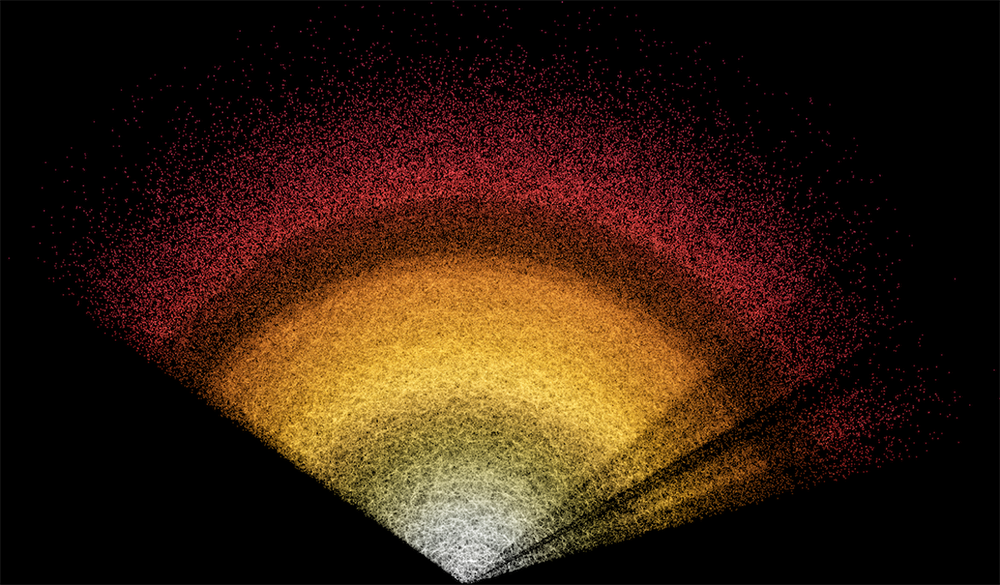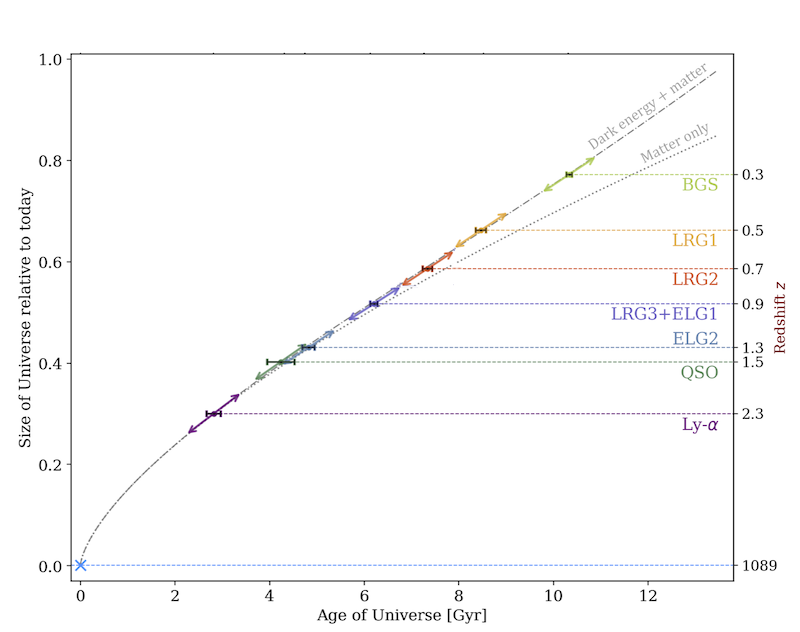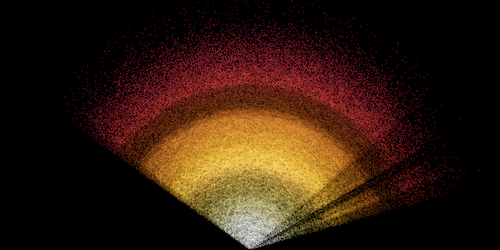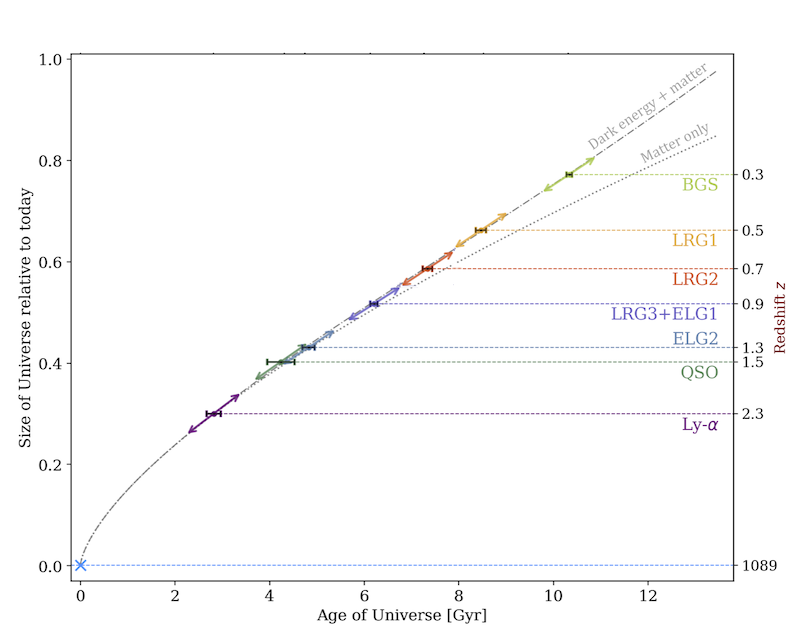Matteo VielAstroparticle and Gravitational Physics Group, International School for Advanced Studies (SISSA), Trieste, Italy
October 6, 2025• Physics 18, 130
The new map of the Universe’s expansion history released by the DESI Collaboration offers hints at a breakdown of the standard model of cosmology.
C. Lamman/DESI Collaboration
Figure 1: A slice of DESI’s first three years of data—constituting the largest 3D map of the Universe made so far.

C. Lamman/DESI Collaboration
Figure 1: A slice of DESI’s first three years of data—constituting the largest 3D map of the Universe made so far.×
For nearly a century, we have known that our Universe is expanding. For the past quarter-century, we have also known that this expansion is accelerating, a discovery that earned the 2011 Nobel Prize in Physics [1, 2]. But what is the mysterious “dark energy” that drives this acceleration? The simplest explanation involves what Einstein dubbed a “cosmological constant” (Λ) and implies that dark energy is a constant energy inherent to spacetime itself. This idea is the cornerstone of the standard model of cosmology, the Λ cold dark matter (ΛCDM) model, which for decades has consistently explained all available astronomical observations. Now high-precision measurements of the Universe’s expansion history are putting this model to its most stringent test yet. The Dark Energy Spectroscopic Instrument (DESI) has created a cosmic map of unprecedented scale (Fig. 1) [3–9]. Its findings, combined with those from other observations, suggest that dark energy might not be so constant after all, a tantalizing hint that our understanding of the cosmos may be on the verge of a major revision.
To map the expansion of the Universe, cosmologists need a “standard ruler,” an astronomical “yardstick” with known physical size. Such a ruler is offered by baryon acoustic oscillations (BAOs), faint ripples left over from the Universe’s infancy. In the hot, dense plasma of the early Universe (about 380,000 years after the big bang), sound waves flowed outward from regions of high density, much like waves from a pebble dropped in a pond. As the Universe expanded and cooled, the photons that drove these waves decoupled from matter, and the ripples effectively “froze” in place, leaving a characteristic scale imprinted on the cosmos. This scale is observable through a slight preference for galaxies (and other astrophysical objects) to be separated by about 147 million megaparsecs (or 480 million light-years), the distance the sound waves traveled from the big bang to the freeze-out time. The BAO scale at that time can be precisely determined from observations of the cosmic microwave background (CMB) [10].
M. Abdul Karim et al. (DESI Collaboration) [4]
Figure 2: Reconstructed map of the size of the Universe relative to today showing how the measurements line up along a theory curve that implies the presence of dark energy and matter. DESI uses different tracers to probe different cosmic epochs: Bright Galaxy Survey (BGS); luminous red galaxies (LRGs); emission-line galaxies (ELGs); quasistellar objects (QSOs), or quasars; and Lyman-alpha forest (Ly-𝛼).

M. Abdul Karim et al. (DESI Collaboration) [4]
Figure 2: Reconstructed map of the size of the Universe relative to today showing how the measurements line up along a theory curve that implies the presence of dark energy and matter. DESI uses different tracers to probe different cosmic epochs: Bright Galaxy Survey (BGS); luminous red galaxies (LRGs); emission-line galaxies (ELGs); quasistellar objects (QSOs), or quasars; and Lyman-alpha forest (Ly-𝛼).×
By observing the apparent size of this ruler at different points in cosmic history, cosmologists can measure how fast the Universe expanded as a function of time. Building on the previous efforts by the Sloan Digital Sky Survey [11], DESI performed a monumental survey that maps the 3D positions of tens of millions of celestial objects. The survey chooses different types of objects, or “tracers,” to probe different cosmic eras (Fig. 2). For the nearby Universe (up to a redshift of z ≈ 0.4), its Bright Galaxy Survey uses a sample of galaxies bright enough to be observable under an almost full moon. To peer deeper, DESI targets two types of objects: “luminous red galaxies” (massive galaxies mostly composed of old stars) and “emission-line galaxies” (younger galaxies detectable through a characteristic emission associated with star formation). To map the most distant epochs (z > 2), DESI uses quasars, galaxies whose extremely bright cores are powered by supermassive black holes. The light from these distant quasars passes through the high-redshift cosmic web, a vast network of filaments, sheets, and voids. The hydrogen contained in this web creates a pattern of absorption lines—the Lyman-alpha forest—that traces baryonic matter distribution and thus BAOs. DESI’s high-redshift Lyman-alpha-forest analysis probes the Universe up to 11 billion years ago through the spectra from over 820,000 quasars [4].
The new results combine all these tracers—from nearby galaxies to distant quasars—to produce the most comprehensive map of our Universe to date. The analysis encompasses data on over 14 million galaxies and quasars collected in the survey’s first three years. The resulting precision is stunning: For most of the cosmic epochs measured, the uncertainty on the BAO scale is less than 1%, an improvement of about 30%–50% compared to the first DESI data release—an impressive, record-breaking effort to constrain the geometry of our Universe.
The DESI researchers analyzed these measurements within the framework of the standard ΛCDM model, finding that it provides a good fit to their data. However, the model parameters that best fit the DESI data are in mild but growing tension with the parameters derived from CMB observations [10]. Up to a few years ago, the agreement between DESI and CMB analyses were, within the quoted uncertainties, consistent with each other. The new results suggest a potential disagreement, with the statistical tension between the approaches now standing at a 2.3-sigma level—not yet significant enough to claim a discovery, yet highly intriguing.
The plot thickens when considering an alternative to the cosmological constant in which dark energy is not constant. The DESI team tested a more flexible model where the key parameter for the “equation of state” of dark energy w, defined as the ratio between pressure and density, can change over time. For a cosmological constant, w is fixed to be equal to –1 at all times. Allowing w to evolve provides a better fit to the DESI data. What’s more, when combining data from DESI with those from other measurements, including those of the CMB and of supernovae, the preference for this evolving-dark-energy model reaches a significance as high as 4.2 sigma, hinting that dark energy might have grown stronger at more recent times. If confirmed, this will be a monumental discovery.
We live in an incredibly exciting time for cosmology. While these DESI results are not a “smoking gun” that overturns our standard model, they are a powerful piece of evidence suggesting that the ΛCDM model may be incomplete. The sheer precision of the DESI measurements is a game changer: Any alternative theory for dark energy will have to align with these incredibly sharp measurements of our expansion history. DESI’s work sets a new benchmark for the field.
What makes the results even more compelling is the fact that DESI is not finished. The results presented here are based on the first three years of a five-year survey. The larger and more precise final dataset will offer the potential of ruling out a statistical fluke and confirming the tension beyond the 5-sigma threshold needed to claim a discovery. The synergies with other forthcoming high-precision experiments will also be crucial. Such experiments include geometrical BAO measurements from galaxy clustering, like those provided by the Euclid satellite, and the characterization of structure growth derived from the weak-lensing data of the Vera C. Rubin Observatory (see Research News: First Takes of the Largest Astronomical Movie Ever).
Whether future data solidify the standard model and force us to reexamine potential systematic errors, or confirm the need for new physics, the outcome will be profound. DESI’s second data release has challenged our simplest picture of the Universe, and cosmologists around the world are eagerly awaiting the five-year map while developing ever-more sophisticated statistical tools to test the robustness of the findings [12].
ReferencesA. G. Riess et al., “Observational evidence from supernovae for an accelerating universe and a cosmological constant,” Astron. J. 116, 1009 (1998).S. Perlmutter et al. (Supernova Cosmology Project), “Measurements of Ω and Λ from 42 high-redshift supernovae,” Astrophys. J. 517, 565 (1999).M. Abdul Karim et al. (DESI Collaboration), “DESI DR2 results. I. Baryon acoustic oscillations from the Lyman alpha forest,” Phys. Rev. D 112, 083514 (2025).M. Abdul Karim et al. (DESI Collaboration), “DESI DR2 results. II. Measurements of baryon acoustic oscillations and cosmological constraints,” Phys. Rev. D 112, 083515 (2025).K. Lodha et al. (DESI Collaboration), “Extended dark energy analysis using DESI DR2 BAO measurements,” Phys. Rev. D 112, 083511 (2025).L. Casas et al. (DESI Collaboration), “Validation of the DESI DR2 Ly𝛼 BAO analysis using synthetic datasets,” Phys. Rev. D (2025).W. Elbers et al. (DESI Collaboration), “Constraints on neutrino physics from DESI DR2 BAO and DR1 full shape,” Phys. Rev. D 112, 083513 (2025).U. Andrade et al. (DESI Collaboration), “Validation of the DESI DR2 measurements of baryon acoustic oscillations from galaxies and quasars,” Phys. Rev. D 112, 083512 (2025).A.Brodzeller et al. (DESI Collaboration), “Construction of the damped Ly𝛼 absorber catalog for DESI DR2 Ly𝛼 BAO,” Phys. Rev. D 112, 083510 (2025).N. Aghanim et al. (Planck Collaboration), “Planck 2018 results. VI. Cosmological parameters,” Astron. Astrophys. 641, A6 (2020).D. J. Eisenstein et al., “Detection of the baryon acoustic peak in the large-scale correlation function of SDSS luminous red galaxies,” Astrophys. J. 633, 560 (2005).D. H. Weinberg et al., “Observational probes of cosmic acceleration,” Phys. Rep. 530, 87 (2013).About the Author
Matteo Viel is a cosmologist working primarily on constraining fundamental physics by looking at high-redshift structure-formation processes. He received his PhD from the University of Padua, Italy, and moved to the Institute of Astronomy at the University of Cambridge, UK, for a postdoctoral appointment. He then became a staff researcher at the National Institute of Astrophysics, Italy, and a full professor at the International School for Advanced Studies (SISSA), Italy. He was the head of SISSA’s Astroparticle and Gravitational Physics Group from 2018 to 2022 as well as the PhD-curriculum coordinator. He currently investigates the Universe by running large computer simulations and comparing these with the data provided by surveys like DESI.
Subject AreasRelated Articles

 More Articles
More Articles



